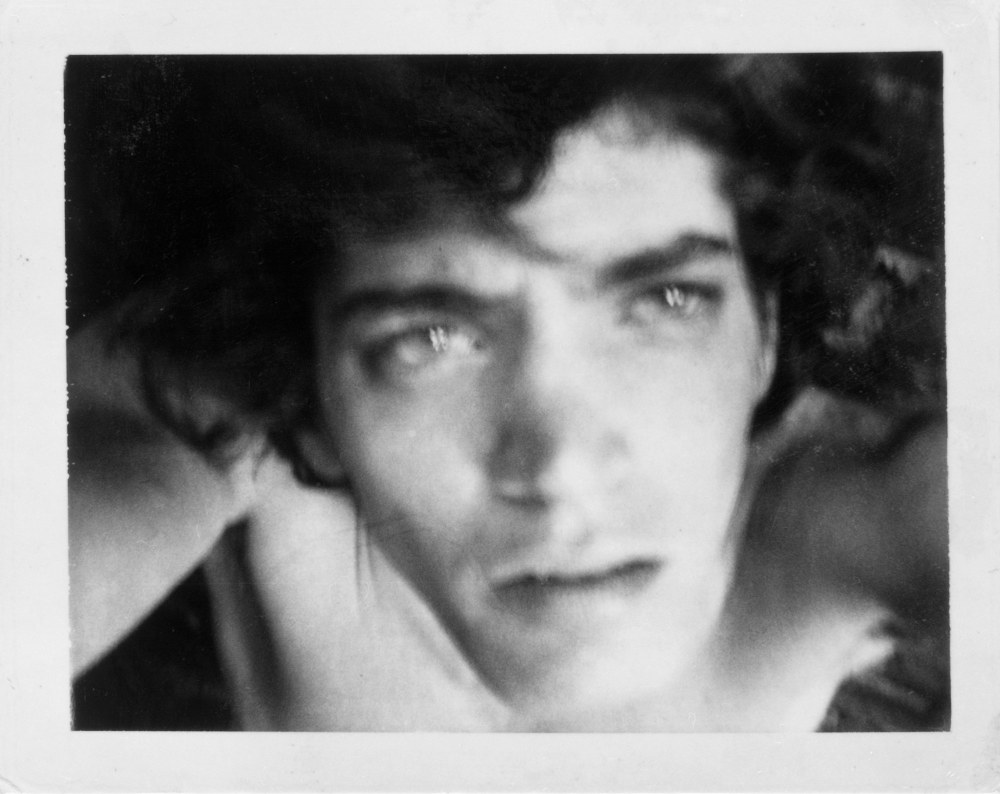
Self Portrait, 1972, Polaroid
Spontaneity Was the Medium and the Message
Since Polaroid announced in February that it would stop manufacturing instant film and that supplies would run out next year, artists like Chuck Close and Lucas Samaras have been passing through stages of grief. Nothing, they say, can replace the Polaroid awkward, dated, a little sleazy, but miraculous nonetheless.
The beloved instant photograph could not have hoped for a better sendoff than the Whitney’s exhibition of Robert Mapplethorpe’s Polaroids. During his 20s, between 1970 and 1975, Mapplethorpe made more than 1,500 photographs with Polaroid cameras. This may surprise viewers who are more familiar with his posed and polished studio photography of the ’80s.
“Polaroids: Mapplethorpe” offers some 100 examples drawn largely from the Robert Mapplethorpe Foundation, including portraits, still lifes, erotica and works that fall into more than one of these categories. All the themes of Mapplethorpe’s mature work the body as a site of pain and pleasure, the ideals of classical beauty, the celebration of alternative lifestyles are here, but rendered in a more spontaneous medium.
As Mapplethorpe once said, “If I were to make something that took two weeks to do, I’d lose my enthusiasm. It would become an act of labor, and the love would be gone.”
Sylvia Wolf, the show’s curator in collaboration with the Robert Mapplethorpe Foundation, writes in the catalog that Mapplethorpe “learned how to see photographically with the Polaroid camera.” The growth was personal as well as artistic. Mapplethorpe’s earliest Polaroids date from 1970, around the time he was beginning to explore his sexual identity.
His early self-portraits are frankly autoerotic, taking full advantage of the Polaroid’s seamy associations (from the days before cellphone cameras). Instead of leafing through pornographic magazines to find a desired pose, as he had for earlier collage-based works, Mapplethorpe could simply create it himself.
This being the Whitney, the exhibition does not include some of the more provocative images that appear in the catalog. It’s too bad, because it interrupts sequences of shots and plays down the Polaroid’s seductive function.
A card from Mapplethorpe’s 1973 opening at the uptown Light Gallery made the connection explicit. Invitees opened cream-colored Tiffany envelopes to find a protective sleeve for Polaroid film, printed with the words “DON’T TOUCH HERE.” Inside was a self-portrait made by positioning a Polaroid camera at crotch level across from a mirror. A strategically placed paper dot added a touch of false modesty.
The Polaroid technology was inherently collaborative, in that models could see and respond to the results of the photo session. This is particularly apparent in shots of Mapplethorpe’s friend and roommate Patti Smith. The ever-aloof Ms. Smith crosses her arms, hugs her knees and thrusts her hands into her pockets, but there is a sense that she might crack a smile.
The romantic and creative relationship between Mapplethorpe and the collector Sam Wagstaff, which began in 1972, inspired some of the most intimate photographs in this exhibition. A series of three subtly erotic Polaroids, mounted on paper and separated with thin bands of colored pencil, shows Wagstaff rinsing his hair and shaving his chiseled jawline in the bath.
Mapplethorpe often created special mountings for his Polaroids, though only a few examples are at the Whitney. One such 1973 work combines four images of the Warhol superstar Candy Darling, each surrounded by pastel-painted plastic. Another, also from 1973, features a grid of six Polaroids in which racy portraits of Mapplethorpe and David Croland, his friend and one of his early lovers, alternate with photographs of a public sculpture.
In works made the following year, Mapplethorpe continued to depict the nude body athletic but not necessarily male as classical statuary. Several Polaroids show dancers and performers posing next to columns and on pedestals. In one photograph of a male dancer from 1974, taken opposite a mirror, Mapplethorpe can be seen crouching with his camera in the lower right corner.
In other photographs Mapplethorpe and his models wear masks, harnesses and other sexual accessories, but even these pictures have a cold, flesh-as-marble sensibility. More shocking, in a way, is a photograph of two men (“Charles and Jim”) kissing in a bathhouselike setting. In the catalog Ms. Wolf compares this image to Warhol’s taboo-defying film “Kiss.”
By the mid-’70s, Mapplethorpe had gained access to the upper echelons of creative society and was able to make a living by taking portraits. His Polaroids from this time form an impressive social archive: Ozzie Clark, Clarissa Dalrymple, Henry Geldzahler. In these pictures Mapplethorpe seems to have used the Polaroid as if it were a more conventional camera. Only the shots of Marianne Faithfull, cradling a cup of tea, and Helen Marden, veiled by a leafy branch, possess the immediacy of Mapplethorpe’s earlier portraits of Ms. Smith.
In 1975 Wagstaff gave Mapplethorpe a Hasselblad 2 1/4-inch camera. It was the end of Mapplethorpe’s affair with the Polaroid. By then he had outgrown it.
The photographs of the early ’70s show us that Mapplethorpe did not emerge fully formed as a photographer of “the perfect moment.” How might his art have developed without the Polaroid? We can only guess, but it is difficult to picture young artists approaching their camera phones and Webcams with anything like his sense of wonder.